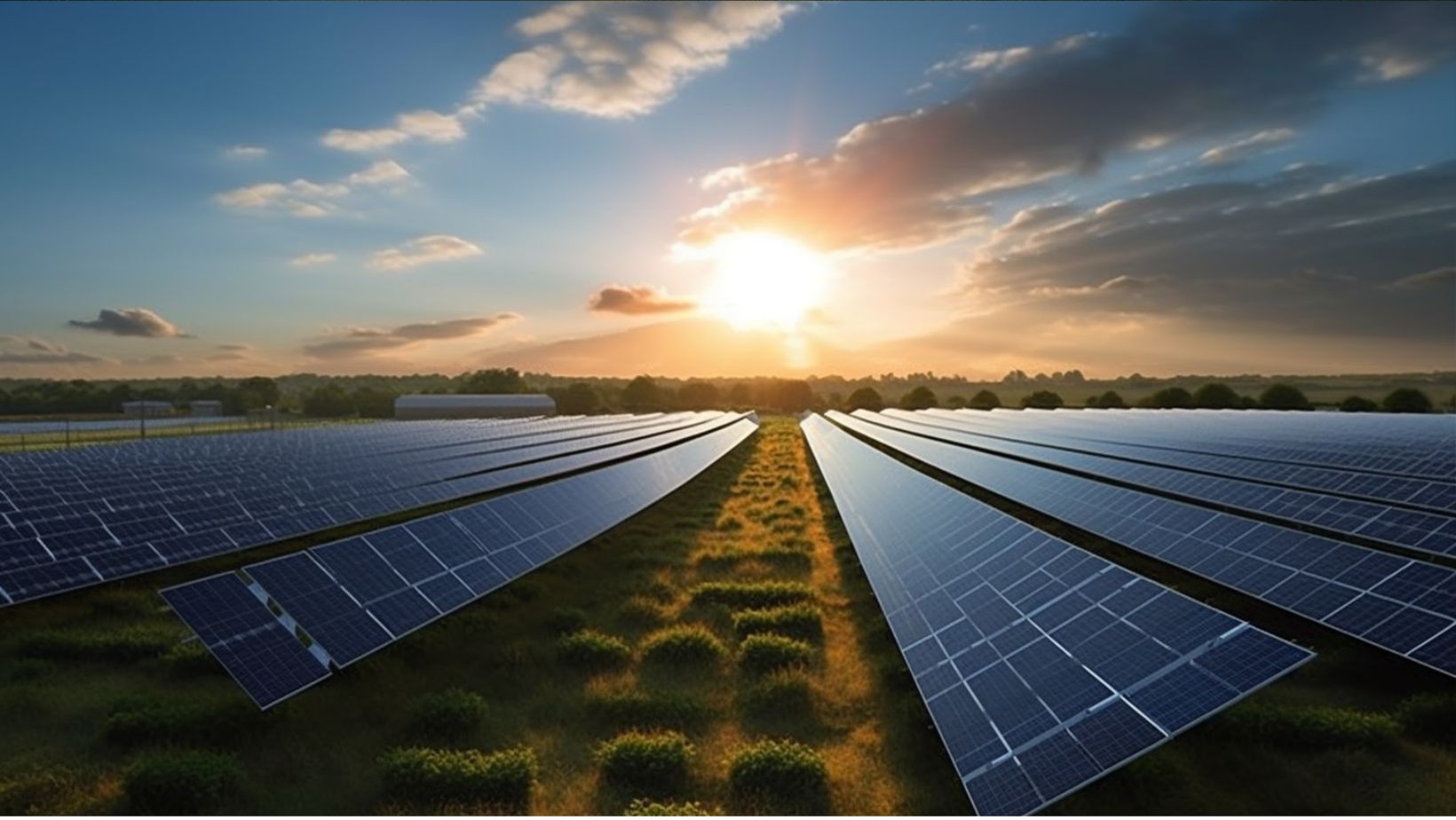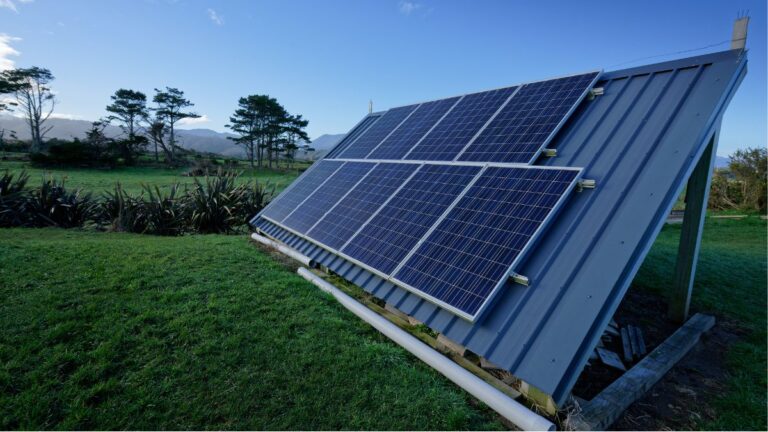From Shotwick to Bradenstoke: Largest Solar Farms In England
In the sunny landscapes of England, a quiet but powerful revolution is underway. From the sprawling fields of Shotwick to the scenic expanses of Bradenstoke, the largest solar farms in England are harnessing the sun’s energy to light up our lives.
With an increasing number of these solar power plants dotting the countryside, England is making significant strides towards a more sustainable future. Join us as we explore the impact and potential of these incredible feats of engineering and innovation.
What is a Solar Farm
A solar farm is a large-scale installation of solar panels used to generate electricity from sunlight. There are two main types of solar farms: ground-mounted and rooftop. Ground-mounted solar farms are typically located in open spaces, such as fields or deserts, while rooftop solar farms are installed on the roofs of buildings.
Solar farms offer several benefits, including reducing greenhouse gas emissions, diversifying energy sources, and creating jobs. The installation of solar farms involves positioning solar panels in an optimal location to maximize sunlight exposure. Maintenance of solar farms includes regular cleaning of panels and monitoring their performance.
Financing for solar farms can be obtained through various means, such as government incentives, power purchase agreements, and private investments. Overall, solar farms are a sustainable and efficient way to generate clean energy.
Solar Farms in England
The increasing prominence of solar energy generation in the country is reflected in the establishment of several significant installations across England.
Solar farms, also known as solar parks or solar power plants, are large-scale installations that harness solar energy through photovoltaic (PV) panels. These farms make use of advanced solar farm technology to efficiently convert sunlight into electricity.
Solar farm development has been driven by the UK government’s commitment to renewable energy sources and the need to reduce carbon emissions. Regulations surrounding solar farms ensure proper planning permissions, environmental assessments, and adherence to grid connection requirements.
With advancements in solar farm efficiency, these installations are becoming more cost-effective and are able to generate a significant amount of clean energy. Regular solar farm maintenance is essential to ensure optimal performance and longevity of the panels and other equipment.
Overall, solar farms in England play a crucial role in the transition towards a greener and more sustainable energy future.
The Largest Solar Farm in the United Kingdom
One notable example of a significant solar energy installation in the United Kingdom is an expansive site that harnesses the power of the sun to generate electricity. This installation is known as the largest solar farm in the country. Situated in the southern region of the UK, this solar farm covers a vast area and is home to thousands of solar panels.
The project is part of the country’s ambitious plans to increase renewable energy generation and reduce carbon emissions. The solar farm uses state-of-the-art technology and efficient solar panels to maximize energy production.
With its impressive scale and cutting-edge technology, this solar farm serves as a shining example of the potential of solar energy in the UK and its contribution to a sustainable future.
The Biggest Solar Farms in England
Situated in various regions across the country, these expansive solar installations in England contribute significantly to the generation of renewable energy and the reduction of carbon emissions. With community involvement and government incentives, these solar farms have become an integral part of England’s efforts to transition towards sustainable energy sources.
The use of advanced solar panel technology has made these farms highly efficient in converting sunlight into electricity. Not only do these solar farms provide clean energy, but they also have minimal impact on land use. By utilizing large open spaces and previously unused land, these solar farms demonstrate how renewable energy can be harnessed without compromising valuable resources.
As England continues to expand its renewable energy portfolio, these solar farms play a crucial role in achieving a greener and more sustainable future.
Impact and Future of Solar Farms in England
Solar farms in England are poised to have a significant impact on the country’s energy landscape, with their continued growth and advancement paving the way for a more sustainable and greener future.
The impact assessment of these solar farms reveals their immense contribution to renewable energy generation. As of now, the largest solar farm in England, Shotwick Solar Park, produces enough clean energy to power over 14,000 homes.
Community engagement has been a key factor in the success of these solar farms, with local residents and businesses actively participating in their development and operation.
Government incentives, such as feed-in tariffs and renewable obligation certificates, have encouraged the expansion of solar farms across the country.
Technological advancements in solar panel efficiency and storage capabilities have further enhanced the viability and scalability of solar energy.
With ongoing advancements and increased adoption, solar farms are playing a crucial role in reducing carbon emissions and building a sustainable energy future for England.
Advantages of Solar Farms
Solar farms offer several benefits that make them a valuable addition to the energy landscape. Firstly, solar energy is a renewable resource, meaning it will never run out. This makes solar farms a sustainable and long-term solution for meeting our energy needs.
Moreover, solar farms are cost-effective in the long run. While the initial investment may be significant, the operational costs are low compared to traditional fossil fuel power plants. Solar farms also provide a stable source of electricity, reducing reliance on fluctuating fuel prices.
Additionally, solar farms contribute to reduced carbon emissions, helping combat climate change. By harnessing the power of the sun, solar farms generate clean energy without producing harmful greenhouse gases. This makes them crucial in our transition towards a greener and more sustainable future.
Furthermore, solar farms create job opportunities, supporting local economies and fostering community development. From installation and maintenance to research and development, the solar industry offers a wide range of employment prospects.
Lastly, solar farms promote energy independence. By producing electricity locally, communities can reduce their dependence on fossil fuel imports and establish a more resilient and self-sufficient energy system.
Overall, solar farms offer numerous advantages, including cost effectiveness, renewable energy generation, reduced carbon emissions, job creation, and energy independence. These benefits make solar farms a compelling choice for a sustainable and prosperous future.
Disadvantages of Solar Farms
One potential drawback of large-scale solar energy projects is the amount of land that they require for installation. While solar farms play a crucial role in generating clean and renewable energy, their development can have several disadvantages.
Firstly, solar farms require vast expanses of land, which can lead to the displacement of natural habitats and ecological disruption. Additionally, the installation of solar panels can alter the local landscape and scenic views.
From an economic standpoint, solar farms may face higher initial costs compared to other energy sources, which can impact their financial viability. Moreover, concerns from the community may arise regarding the visual impact, noise, and potential decrease in property values.
It is important to consider these factors and engage in careful planning and consultation processes to mitigate the negative impacts associated with solar farms.
How Solar Farms Benefit the Environment
Solar farms play a crucial role in reducing our reliance on fossil fuels and mitigating climate change. As sources of renewable energy, they have a significantly lower carbon footprint compared to traditional power plants. By harnessing the power of the sun, solar farms generate clean electricity without emitting harmful greenhouse gases.
In addition to addressing global warming, solar farms also promote energy independence. By diversifying our energy sources, we become less dependent on volatile fossil fuel markets and foreign oil imports. This enhances our national security and economic stability.
Moreover, solar farms have positive impacts on wildlife conservation. When properly designed and managed, they can provide habitat for pollinators and other beneficial species. By avoiding harmful practices such as excessive pesticide use, solar farms can contribute to preserving biodiversity.
Lastly, solar farms create job opportunities. According to the Solar Energy Industries Association, the solar industry employs hundreds of thousands of people, offering stable and well-paying jobs that support local economies.
How Solar Farms Benefit the Economy
In addition to creating job opportunities, solar farms also contribute to economic growth through increased investments in local communities. The economic impact of solar farms extends beyond job creation, as these projects often require significant investment in infrastructure, construction, and maintenance.
According to a report by the Solar Energy Industries Association, the solar industry contributed $18.7 billion to the US GDP in 2020 alone. This revenue generation not only supports local businesses but also benefits the wider economy.
Solar farms also promote energy independence by reducing reliance on fossil fuels and increasing the use of clean, renewable energy sources. As governments and businesses invest more in solar farms, the economic benefits will continue to grow, providing long-term sustainability and prosperity for local communities.
Benefits of Solar Farms in the Home
The installation of solar panels in residential homes offers homeowners the opportunity to reduce their electricity bills and contribute to a more sustainable future. Solar energy is a renewable source of energy that harnesses the power of the sun to generate electricity. By using solar panels, homeowners can tap into this clean and abundant source of energy, reducing their reliance on traditional fossil fuels and lowering their carbon emissions.
One of the key benefits of installing solar panels is the potential for cost savings. Solar energy can significantly reduce or even eliminate monthly electricity bills, providing long-term financial benefits for homeowners. Additionally, solar panels can increase the value of a home, making it a wise investment for homeowners.
Furthermore, embracing solar energy enables homeowners to achieve energy independence. By generating their own electricity, homeowners are less dependent on the grid and can have peace of mind during power outages or fluctuations in energy prices.
Another advantage of residential solar panels is the positive impact on job creation. The solar industry is a rapidly growing sector, creating numerous job opportunities in installation, manufacturing, and maintenance. As more homeowners adopt solar energy, the demand for skilled workers in this field continues to rise, contributing to local economic growth.
What Solar Farm Components Are Used
Solar farm components consist of photovoltaic modules, inverters, mounting structures, and monitoring systems, all working together to capture and convert sunlight into usable electricity. These components form the backbone of solar farm infrastructure, enabling the generation of clean and renewable energy on a large scale.
Photovoltaic modules, commonly known as solar panels, are responsible for converting sunlight into direct current (DC) electricity. Inverters then convert this DC electricity into alternating current (AC) electricity, which can be fed into the power grid.
Mounting structures provide the necessary support and orientation for optimal sunlight exposure. Additionally, monitoring systems allow for real-time monitoring of performance and ensure efficient operation.
The installation of solar farm equipment requires careful planning and consideration of factors such as location, tilt angle, and shading to maximize energy output. As solar farm technology continues to advance, these components play a crucial role in harnessing the power of the sun to meet the growing demand for clean energy.
How Do Solar Farms Generate Electricity
Solar farms generate electricity by harnessing the power of the sun through the use of photovoltaic (PV) technology. This technology involves the installation of solar panels, which are made up of silicon cells that convert sunlight into direct current (DC) electricity. The efficiency of a solar farm depends on several factors, including the quality and orientation of the panels, the amount of sunlight received, and the overall design of the system.
The installation of a solar farm involves careful planning and engineering to maximize its potential. This includes selecting suitable locations with ample sunlight, arranging the panels in optimal configurations, and connecting them to a grid for distribution. Ongoing maintenance is also crucial for ensuring the longevity and performance of the solar farm. Regular inspections, cleaning, and repairs are necessary to keep the panels functioning at their highest efficiency.
Financing plays a significant role in the development of solar farms. Various funding options, such as government incentives and private investments, are available to support the installation and operation of these facilities. Advances in solar farm technology and financing options continue to drive the expansion of this renewable energy source, contributing to a greener and more sustainable future.
Conclusion
Solar farms in England have significantly contributed to the country’s renewable energy goals and economic growth. The largest solar farm in the United Kingdom, as well as several other big solar farms in England, have played a crucial role in generating electricity from clean sources.
These solar farms not only benefit the economy but also have positive impacts on the environment by reducing carbon emissions. With ongoing advancements in solar technology, the future of solar farms in England looks promising in terms of meeting energy demands sustainably.






